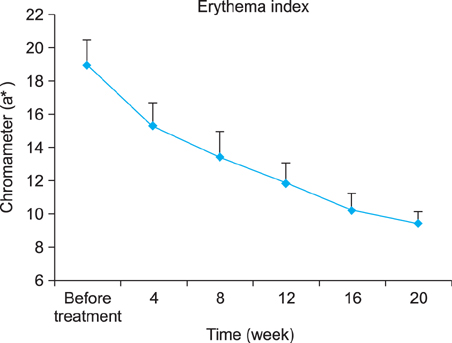Ann Dermatol.
2014 Apr;26(2):156-161. 10.5021/ad.2014.26.2.156.
Pilot Study of the Efficacy of 578 nm Copper Bromide Laser Combined with Intralesional Corticosteroid Injection for Treatment of Keloids and Hypertrophic Scars
- Affiliations
-
- 1Department of Dermatology, Chung-Ang University College of Medicine, Seoul, Korea. beomjoon@unitel.co.kr
- KMID: 2171649
- DOI: http://doi.org/10.5021/ad.2014.26.2.156
Abstract
- BACKGROUND
Treatments including intralesional corticosteroid injection, pressure therapy, cryotherapy, and various laser therapies have had limited success for keloids and hypertrophic scars.
OBJECTIVE
This trial evaluated the efficacy of a combination of 578 nm copper bromide laser and the more traditional intralesional corticosteroid injection for the treatment of keloids and hypertrophic scars with respect to scar color.
METHODS
Keloids or hypertrophic scars of 12 Korean patients were treated five times by the combined treatment at 4-week intervals. Clinical improvement was assessed by the physicians' global assessment (PGA) comparing pre- and post-treatment photographs, as well as 4 weeks after the last treatment. Erythema intensity was quantified using a mexameter.
RESULTS
Most scars showed significant clinical improvement in PGA and decreased erythema intensity after 5 treatments. All patients showed improvements in symptoms like pruritus.
CONCLUSION
The combined treatment is effective for keloids and hypertrophic scars, especially when the telangiectatic portion of the scars is prominent. The adjunctive use of 578 nm copper bromide laser decreased the telangiectatic side effects of an intralesional corticosteroid injection by reducing the vascular components of scars.
Keyword
MeSH Terms
Figure
Cited by 2 articles
-
Oxidative Damage and Nuclear Factor Erythroid 2-Related Factor 2 Protein Expression in Normal Skin and Keloid Tissue
Yoon Jin Lee, Sun Bum Kwon, Chul Han Kim, Hyun Deuk Cho, Hae Seon Nam, Sang Han Lee, Mi Woo Lee, Doo Hyun Nam, Chang Yong Choi, Moon Kyun Cho
Ann Dermatol. 2015;27(5):507-516. doi: 10.5021/ad.2015.27.5.507.Combined Treatment with Botulinum Toxin and 595-nm Pulsed Dye Laser for Traumatic Scarring
Sang Ju Lee, Se Yeong Jeong, Yeon A No, Kui Young Park, Beom Joo Kim
Ann Dermatol. 2015;27(6):756-758. doi: 10.5021/ad.2015.27.6.756.
Reference
-
1. English RS, Shenefelt PD. Keloids and hypertrophic scars. Dermatol Surg. 1999; 25:631–638.
Article2. Khatri KA, Mahoney DL, McCartney MJ. Laser scar revision: A review. J Cosmet Laser Ther. 2011; 13:54–62.
Article3. Wolfram D, Tzankov A, Pülzl P, Piza-Katzer H. Hypertrophic scars and keloids--a review of their pathophysiology, risk factors, and therapeutic management. Dermatol Surg. 2009; 35:171–181.
Article4. Connell PG, Harland CC. Treatment of keloid scars with pulsed dye laser and intralesional steroid. J Cutan Laser Ther. 2000; 2:147–150.
Article5. Alster TS, West TB. Treatment of scars: a review. Ann Plast Surg. 1997; 39:418–432.
Article6. Munro KJ. Treatment of hypertrophic and keloid scars. J Wound Care. 1995; 4:243–245.
Article7. Alster T. Laser scar revision: comparison study of 585-nm pulsed dye laser with and without intralesional corticosteroids. Dermatol Surg. 2003; 29:25–29.
Article8. Wittenberg GP, Fabian BG, Bogomilsky JL, Schultz LR, Rudner EJ, Chaffins ML, et al. Prospective, single-blind, randomized, controlled study to assess the efficacy of the 585-nm flashlamp-pumped pulsed-dye laser and silicone gel sheeting in hypertrophic scar treatment. Arch Dermatol. 1999; 135:1049–1055.
Article9. Alster T, Zaulyanov L. Laser scar revision: a review. Dermatol Surg. 2007; 33:131–140.
Article10. Sadick NS, Weiss R. The utilization of a new yellow light laser (578 nm) for the treatment of class I red telangiectasia of the lower extremities. Dermatol Surg. 2002; 28:21–25.
Article11. Kiil J. Keloids treated with topical injections of triamcinolone acetonide (kenalog). Immediate and long-term results. Scand J Plast Reconstr Surg. 1977; 11:169–172.
Article12. Donkor P. Head and neck keloid: treatment by core excision and delayed intralesional injection of steroid. J Oral Maxillofac Surg. 2007; 65:1292–1296.
Article13. Golladay ES. Treatment of keloids by single intraoperative perilesional injection of repository steroid. South Med J. 1988; 81:736–738.
Article14. Urioste SS, Arndt KA, Dover JS. Keloids and hypertrophic scars: review and treatment strategies. Semin Cutan Med Surg. 1999; 18:159–171.
Article15. Dinehart SM, Waner M, Flock S. The copper vapor laser for treatment of cutaneous vascular and pigmented lesions. J Dermatol Surg Oncol. 1993; 19:370–375.
Article16. Lee HI, Lim YY, Kim BJ, Kim MN, Min HJ, Hwang JH, et al. Clinicopathologic efficacy of copper bromide plus/yellow laser (578 nm with 511 nm) for treatment of melasma in Asian patients. Dermatol Surg. 2010; 36:885–893.
Article17. Jonell R, Larkö O. Clinical effect of the copper vapour laser compared to previously used argon laser on cutaneous vascular lesions. Acta Derm Venereol. 1994; 74:210–211.18. van Gemert MJ, Welch AJ, Pickering JW, Tan OT, Gijsbers GH. Wavelengths for laser treatment of port wine stains and telangiectasia. Lasers Surg Med. 1995; 16:147–155.
Article19. Anderson RR, Parrish JA. Selective photothermolysis: precise microsurgery by selective absorption of pulsed radiation. Science. 1983; 220:524–527.
Article20. McCoy SE. Copper bromide laser treatment of facial telangiectasia: results of patients treated over five years. Lasers Surg Med. 1997; 21:329–340.
Article21. Sheehan-Dare RA, Cotterill JA. Copper vapour laser (578 nm) and flashlamp-pumped pulsed tunable dye laser (585 nm) treatment of port wine stains: results of a comparative study using test sites. Br J Dermatol. 1994; 130:478–482.
Article22. Yoo KH, Kim BJ, Kim MN. Efficacy of high-energy copper bromide laser (511 and 578 nm) with for deep infantile haemangioma. Clin Exp Dermatol. 2009; 34:e451–e452.23. Elsaie ML, Choudhary S. Lasers for scars: a review and evidence-based appraisal. J Drugs Dermatol. 2010; 9:1355–1362.
- Full Text Links
- Actions
-
Cited
- CITED
-
- Close
- Share
- Similar articles
-
- Bleomycin Intralesional Injection in Keloids and Hypertrophic Scars Unresponsive to Previous Corticosteroid Intralesional Injection and/or Laser Treatment: A Case Series and Review of the Literature
- Comparative Study of a Combination of Intralesional Corticosteroid, 5-fluorouracil and/or Pulsed Dye Laser for the Treatment of Keloids and Hypertrophic Scars
- The Clinical Analysis of the Combination of Cryosurgery and Intralesional Corticosteroid for Keloid or Hypertrophic Scars
- Combined Treatment of Keloids or Hypertrophic Scars
- A Combined Therapy of Steroid Injection, Silicone Gel Sheeting, and Laser for Hypertrophic Scar and Keloid




